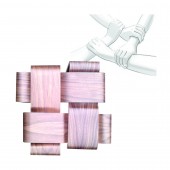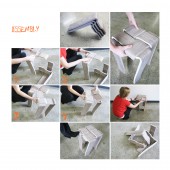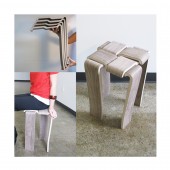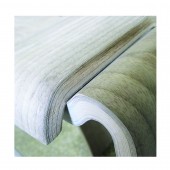DESIGN NAME:
L-Stool
PRIMARY FUNCTION:
Stool
INSPIRATION:
Combining the clean lines that follow the traditional Japanese design style, pure functionality and a modern aesthetic, I wanted to design a unique and intriguing stool with a different approach to seating. The idea of the stool came from my childhood when we used to lift a person by holding hands and creating a seat. Four parts of the stool overlapping each other create a strong structure that is able to support a person’s weight, imitating four woven hands. Its name is based on its appearance. The shape of each part refers to the letter "L" which stands for "Love". This stool is a symbol of support and care.
UNIQUE PROPERTIES / PROJECT DESCRIPTION:
Minimalistic style, repetition of the elements and functionality are the key words for this design. The L-Stool is a unique lightweight yet strong seat. Its four parts hold each other like people holding hands. The idea behind the concept is to create a strong unified piece made of four identical separate parts. One part alone can not be strong and steady enough, but with the support of other three it creates a stable structure.
OPERATION / FLOW / INTERACTION:
This 4-legged stool is easy to assemble and requires no tools. The parts woven together create a lightweight yet strong seat. The more weight put on the stool, the stronger it becomes because of its unique interlocking structure. Each part is nesting on another, holding and supporting the next.
The parts are stackable. Detached the pieces take up a very little room for storage or shipping.
In case of damage, it would be easier to replace a single part instead of fixing and replacing the whole stool. Also it allows users to create their own design by buying the parts in various colors and materials then mixing and matching them.
It can be used as a seat or side table, making it very versatile and stylish piece you will always find good use for.
PROJECT DURATION AND LOCATION:
The project started in September 2011 in Detroit.
Finished in December, 2011
FITS BEST INTO CATEGORY:
Furniture Design
|
PRODUCTION / REALIZATION TECHNOLOGY:
4 identical parts.
Material: bent plywood. Also can be made of acrylic, aluminum, etc.
Various materials and manufacturing methods can be used to produce the L-Stool.
SPECIFICATIONS / TECHNICAL PROPERTIES:
Height 18 in x Width 14 in x Depth 14 in
TAGS:
Furniture, Stool, Seating, Plywood, Simple to make, Easy to assembly, Unique furnishing, Minimal, Stackable
RESEARCH ABSTRACT:
This unique seating is inspired by the genius simplicity and pure functionality of folded and overlapped material.
Working on my design I had lots of questions to figure out: How tall it should be? How wide? The angle of the bend? How thick each part should be to be strong enough to support someone's weight and not to be too heavy? What kind of material should I use to follow the curve? Is my idea going to work? Does the user need to use any tools, screws, nails or glue to assemble the stool?
Experimenting with the proportions, materials, and ergonomics I was considering the natural beauty of bent plywood that lends itself well to elegant interesting curves. These elements make up this stool with a true timeless design.
CHALLENGE:
The creative challenge was to look at furnishing from a different perspective and create a unique stool that will differ from anything that exist in the market. I wanted to challenge people's perceptions about standards and take a somewhat surprising, fun and innovative approach.
The concepts exploration was focused on simplicity, functionality and repetition of the elements, trying to find the curve that would look elegant and have the correct proportions to be able to support someone’s weight. To refine and visualize the design I used 3D modeling software, rapid prototype models, paper mock-ups, a scaled plywood model and full-size foam-core mock-ups. After making some corrections the final decision was made and I began to work on a full-sized plywood model.
The first step in the construction process was building the mold that the stool parts would be formed on. Many layers of veneers were glued and placed on the mold in the vacuum bag. Once they came out, they were trimmed and the edges were sanded. Finally, a few layers of clear coat were applied.
ADDED DATE:
2011-09-29 11:40:21
TEAM MEMBERS (1) :
IMAGE CREDITS:
Olena Sydoruk, 2011.
|










